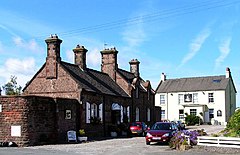This article needs additional citations for verification. (June 2009) |
Drigg is a village situated in the civil parish of Drigg and Carleton on the West Cumbria coast of the Irish Sea and on the boundary of the Lake District National Park in the Borough of Copeland in the county of Cumbria, England.
| Drigg | |
|---|---|
 Drigg railway station and the Victoria Inn | |
Location within Cumbria | |
| Population | 449 (2011) |
| OS grid reference | SD064990 |
| Civil parish | |
| District | |
| Shire county | |
| Region | |
| Country | England |
| Sovereign state | United Kingdom |
| Post town | HOLMROOK |
| Postcode district | CA19 |
| Dialling code | 019467 |
| Police | Cumbria |
| Fire | Cumbria |
| Ambulance | North West |
| UK Parliament | |
Drigg and Carleton parish comprises the areas and settlements of Drigg, Stubble Green, Low Moor, Carleton, Saltcoats, Maudsyke, Wray Head, Hallsenna, Holmrook. The civil parish population at the 2011 census was 449.[1]
Drigg sits to the north of the River Irt, with Carleton to the south of the river. The river runs from Wastwater lake to the Irish Sea. There are three bridges over the river in the parish; the main bridge is in Holmrook which takes the A595 road over the river. The Cumbrian Coast Line railway crosses the River Irt at the head of the tidal estuary where the Irt joins the River Mite at Ravenglass. There is an old small packhorse bridge in the Drigg Holmes which does not take vehicles.
Drigg railway station is on the Cumbrian Coast Line.
The parish has a number of areas of natural interest: the sandy beach and dunes, Hallsenna Moor and Drigg Holmes. Part of the dunes are an important bird reserve, a local nature reserve and a Site of Special Scientific Interest.
Governance
editDrigg is within the Copeland UK Parliamentary constituency, Trudy Harrison is the Member of parliament.
Before Brexit, it was in the North West England European Parliamentary Constituency.
Low Level Waste Repository
editDuring WW2 a Royal Ordnance Factory (ROF Drigg) was established at Drigg between the railway line and the sea. This is now the site of the Nuclear Decommissioning Authority low-level radioactive waste repository. The site, which was opened in 1959 by the United Kingdom Atomic Energy Authority,[2] covers about 270 acres (110 ha), and holds about one million cubic metres of radioactive waste, although historic disposal records are incomplete. Much of the waste came from the nearby Sellafield nuclear complex.[3][4]
See also
editReferences
edit- ^ "Civil parish population 2011". Retrieved 16 June 2015.
- ^ "Low Level Waste Repository". NDA. Archived from the original on 21 April 2014. Retrieved 20 April 2014.
- ^ Terry Macalister (14 February 2009). "Can anyone recall what we put in our nuclear dump?". The Guardian. Retrieved 20 April 2014.
- ^ Rob Edwards (20 April 2014). "Cumbrian nuclear dump 'virtually certain' to be eroded by rising sea levels". The Guardian. Retrieved 20 April 2014.
External links
edit- Cumbria County History Trust: Drigg (nb: provisional research only – see Talk page)
- Drigg Reserve LNR citation

